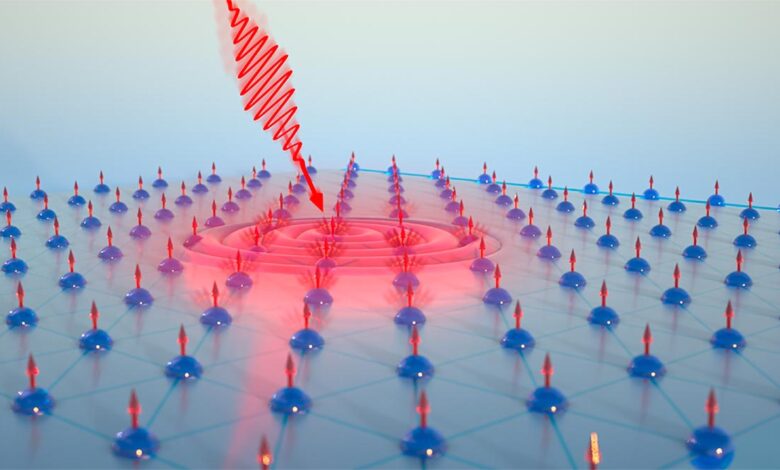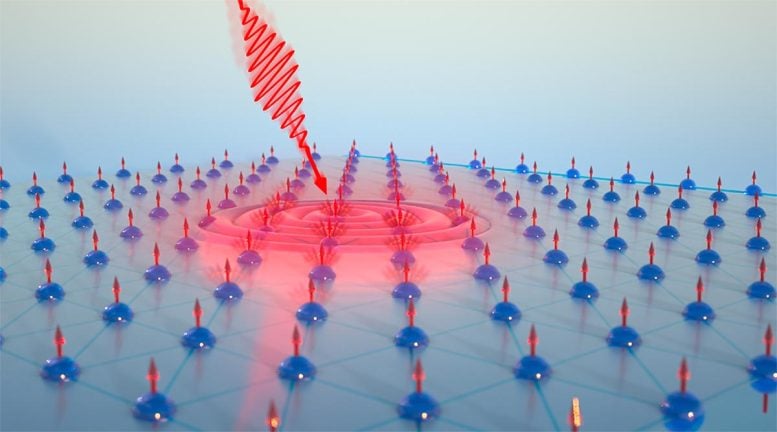A Breakthrough in Quantum and Optical Memory Technology


Researchers at the University of Chicago have made strides in developing an optical memory using MnBi2Te4, a magnetic topological insulator with properties that respond rapidly to light.
This discovery could revolutionize data storage, making it faster and more energy-efficient. The material also exhibits a unique duality in electronic states, balancing between a quantum encoding state and a light-sensitive storage state, promising significant advancements in both quantum and optical data applications.
Researchers at the University of Chicago Pritzker School of Molecular Engineering (PME) have made unexpected progress toward developing a new optical memory that can quickly and energy-efficiently store and access computational data. While studying a complex material composed of manganese, bismuth, and tellurium (MnBi2Te4), the researchers realized that the material’s magnetic properties changed quickly and easily in response to light. This means that a laser could be used to encode information within the magnetic states of MnBi2Te4.
“This really underscores how fundamental science can enable new ways of thinking about engineering applications very directly,” said Shuolong Yang, assistant professor of molecular engineering and senior author of the new work. “We started with the motivation to understand the molecular details of this material and ended up realizing it had previously undiscovered properties that make it very useful.”
In a paper published in on August 9 in the journal Science Advances, Yang and colleagues showed how the electrons in MnBi2Te4 compete between two opposing states – a topological state useful for encoding quantum information and a light-sensitive state useful for optical storage.
“This really underscores how fundamental science can enable new ways of thinking about engineering applications very directly.”
Asst. Prof. Shuolong Yang
Solving a Topological Puzzle
In the past, MnBi2Te4 has been studied for its promise as a magnetic topological insulator (MTI), a material that behaves like an insulator on its interior but conducts electricity on its outer surfaces. For an ideal MTI in the 2D limit, a quantum phenomenon emerges in which an electric current flows in a two-dimensional stream along its edges. These so-called “electron freeways” have the potential to encode and carry quantum data.
While scientists have predicted that MnBi2Te4 should be able to host such an electron freeway, the material has been hard to work with experimentally.
“Our initial goal was to understand why it has been so hard to get these topological properties in MnBi2Te4,” said Yang. “Why is the predicted physics not there?”
To answer that question, Yang’s group turned to cutting-edge spectroscopy methods that let them visualize the behavior of the electrons within MnBi2Te4 in real time on ultrafast time scales. They used time- and angle-resolved photoemission spectroscopy developed in the Yang lab, and collaborated with Xiao-Xiao Zhang’s group at the University of Florida to perform time-resolved magneto-optical Kerr effect (MOKE) measurements, which allows the observation of magnetism.
“This combination of techniques gave us direct information on not only how electrons were moving, but how their properties were coupled to light,” explained Yang.
Optimizing Materials for Future Technologies
When the researchers analyzed their spectroscopy results, it was clear why MnBi2Te4 was not acting as a good topological material. There was a quasi-2D electronic state, which was competing with the topological state for electrons.
“There is a completely different type of surface electrons that replace the original topological surface electrons,” said Yang. “But it turns out that this quasi-2D state actually has a different, very useful property.”
The second electronic state had a tight coupling between magnetism and external photons of light — not useful for sensitive quantum data but the exact requirements for an efficient optical memory.
To further explore this potential application of MnBi2Te4, Yang’s group is now planning experiments in which they use a laser to manipulate the material’s properties. They believe that an optical memory using MnBi2Te4 could be orders of magnitude more efficient than today’s typical electronic memory devices.
Yang also pointed out that a better understanding of the balance between the two electron states on the surface of MnBi2Te4 could boost its ability to act as an MTI and be useful in quantum data storage.
“Perhaps we could learn to tune the balance between the original, theoretically predicted state and this new quasi-2D electronic state,” he said. “This might be possible by controlling our synthesis conditions.”
Reference: “Distinguishing surface and bulk electromagnetism via their dynamics in an intrinsic magnetic topological insulator” by Khanh Duy Nguyen, Woojoo Lee, Jianchen Dang, Tongyao Wu, Gabriele Berruto, Chenhui Yan, Chi Ian Jess Ip, Haoran Lin, Qiang Gao, Seng Huat Lee, Binghai Yan, Chaoxing Liu, Zhiqiang Mao, Xiao-Xiao Zhang and Shuolong Yang, 9 August 2024, Science Advances.
DOI: 10.1126/sciadv.adn5696
Funding: This work was supported by the U.S. Department of Energy and the National Science Foundation
Source link



